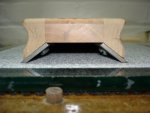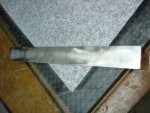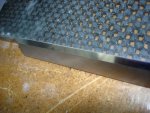- Messages
- 16,933
- Location
- Reno NV
Spent some time getting my pm 54 6" jointer back in shape.
Pulled out the blades and decided to give sharpening them a shot.
So I measured the angle on the blades, and I'll be darned if they weren't 45 degrees. So I cut a little block of wood at 45 and used that as a guide to hone up the blades on my diamond stone until I could shave hairs with it. Did that to all three blades. Then the fun started.
Forgot to mark the TDC before I started sharpening, so put one bladed back in, guessed at TDC and used that as a mark to do the rest of them. Used one of those magnet jigs to set the blades. Then I used a magnetic dial indicator to check it all and set the outfeed table to just slightly (.001 ?) higher than the blades. Does that sound right?
Did some test planing and it seemed to work pretty darn well. Much easier to push the wood through the planer, and it had a much 'smoother' sound than the old dull blades...
Only took a few hours, but I should be back in business...
Pulled out the blades and decided to give sharpening them a shot.
So I measured the angle on the blades, and I'll be darned if they weren't 45 degrees. So I cut a little block of wood at 45 and used that as a guide to hone up the blades on my diamond stone until I could shave hairs with it. Did that to all three blades. Then the fun started.
Forgot to mark the TDC before I started sharpening, so put one bladed back in, guessed at TDC and used that as a mark to do the rest of them. Used one of those magnet jigs to set the blades. Then I used a magnetic dial indicator to check it all and set the outfeed table to just slightly (.001 ?) higher than the blades. Does that sound right?
Did some test planing and it seemed to work pretty darn well. Much easier to push the wood through the planer, and it had a much 'smoother' sound than the old dull blades...
Only took a few hours, but I should be back in business...










